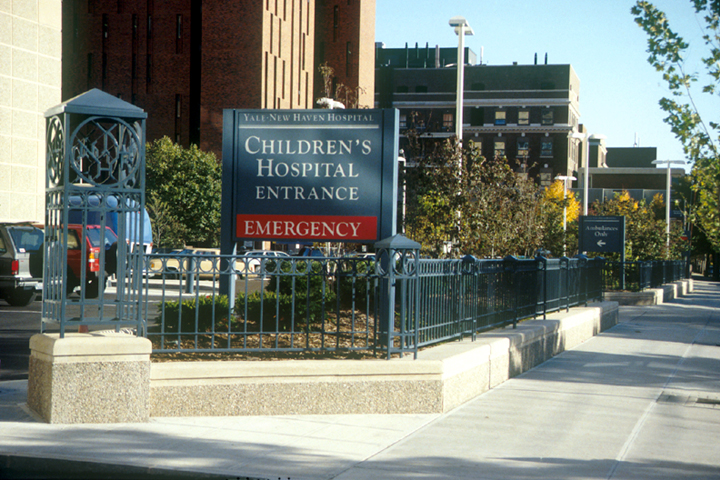In 2014, Connecticut ERs recorded 12,100 Medicaid-insured youth visits compared to 14,448 in 2016, according to a study of Medicaid-eligible patients ages 18 and younger commissioned by the Child Health and Development Institute of Connecticut (CHDI).
Most of the children who go to emergency rooms with behavioral health issues go to one of five hospitals, according to data collected by consultant Beacon Health Options, which manages behavioral health care for the state’s Medicaid population.
Connecticut Children’s Medical Center in Hartford saw the most behavioral health-related ER visits, with 3,962 visits by Medicaid-insured youth in 2016. Yale New Haven Hospital and Yale New Haven Children’s Hospital had a combined total of 2,263 visits, followed by St. Mary’s Hospital in Waterbury with 1,185 and William Backus Hospital in Norwich with 1,203.

The 7-day readmission rate at Connecticut children’s was 9 percent in 2016.
After those 2016 ER visits, the study reported, 10.4 percent of youths were readmitted to the ER within seven days, and 25.6 percent were readmitted within 30 days.
The study’s authors said this indicated that youth and/or family needs were not met or there were issues with families following up with the services offered after discharge.
Hospital emergency departments are often ill-equipped to handle children experiencing behavioral health crises. Those children may benefit more from treatment at community mental health centers, schools or a pediatrician’s office, the report’s authors wrote.
“Emergency departments are not really set up from physical standpoint or from a staffing standpoint to be a primary care behavioral health treatment center,” said Jeff Vanderploeg, the president and CEO of CHDI.
Many of the children did not have a follow-up appointment within a month of their initial trip to the emergency room, the study reported.
The report’s authors reviewed several studies of both nationwide trends and the data from individual hospitals, including one that showed emergency room visits for publicly-insured patients under age 18 experiencing psychiatric problems rose 26 percent from 2001 to 2010.
A 2014 national study cited in the report showed the numbers of psychiatric emergency room visits for children covered by private insurance declined during the same period.
In Connecticut, the 2012 Sandy Hook school shooting prompted state officials to try to reduce behavioral health emergency room visits with initiatives to increase the number of crisis-stabilization beds, create Behavioral Health Assessment Centers and redirect children with autism spectrum disorders to specialized services.
The report’s authors said some of those efforts have been effective, singling out the state’s Mobile Crisis Intervention Service hotline as a “critical alternative” to the ER that parents, guardians and teachers can call to request a clinician who will treat the child at their home or school.
“We have one of the best behavioral health systems for children in the country … and we’re still seeing a large number of children showing up to emergency departments for treatment,” Vanderploeg said.
The report said nearly 1,300 Medicaid-insured children in 2016 were “stuck” in the emergency room after a behavioral health crisis, staying in the hospital for days or weeks before they were discharged, according to the data.

At Yale, the 7-day readmission rate was 10.1 percent.
And about 35 percent of those children did not have a follow-up appointment to see a behavioral or mental health professional in the month after they went to the emergency room. Vanderploeg said that number could indicate poverty, lack of transportation or poor coordination between behavioral health providers are preventing parents and guardians from taking children to mental health appointments.
A CHDI working group that produced the report concluded that the state should try to alleviate pressure on emergency rooms by promoting collaboration between the hospitals, the state’s mobile crisis program and schools, and try to promote follow-up care at community health organizations for children who have been to the emergency room.
“If someone is coming to the ED and the questions are really about how to manage or treat the individual in an ongoing way … the staff are not necessarily trained or focused on addressing those questions,” said Michael Hoge, the director of Yale Behavioral Health at the Yale Department of Psychiatry and a consultant on the working group. “It raised the question of where else they would go,” said Hoge.
Family members of children with behavioral health concerns said they relied on emergency rooms when the child’s behavior was out of control or when the child had suicidal thoughts, often to get a diagnosis or guidance about how to cope, according to the report.
The working group delivered recommendations for state agencies to lessen emergency room visits and improve access to community-based mental health care, including:
• Allowing the Mobile Crisis Performance Improvement Center to focus efforts on increasing collaboration among the mobile crisis programs, the emergency departments, and schools.
• Fund the placement of care coordinators and family support specialists in high-volume emergency rooms.
• Provide telepsychiatry services connecting behavioral health specialists to emergency room staff, a service already available to pediatricians in Connecticut.
• Appropriate funds for the state Department of Children and Families to create Behavioral Health Assessment Centers that would provide evaluation during behavioral health crises, as well as treatment and referral, for children, youth, and families.
Parents can call 2-1-1 to access Connecticut’s Mobile Crisis Intervention Services if their child or adolescent is having a behavioral health crisis that is too much for them to handle on their own. Mobile Crisis responses 24 hours a day, 7 days a week. Services are confidential, and there is no cost to the family.

